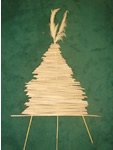Māori kites are known as manu tukutuku or manu aute. Manu is the word for bird and kite, and tukutuku refers to the winding out of the line as the kite climbs. This page has descriptions of several types of kites, and links to further reading on the topic.
Kites and culture
Manu aute is a general name for Māori kites, but it specifically refers to those covered with the bark of the aute (paper mulberry) plant. Manu aute were made in a variety of forms, but tended to be in the shape of a bird.
Kites were often seen as connectors of the heavens and the earth, but they were also a means of communication for instance one village would often signal to the next that a meeting was needed by flying a kite.
Library resources
- Our page on kites
- Our kids page on te manu tukutuku
- Search our catalogue for kite construction titles
Online resources
- Kites and Manu tukutuku from the Te Ara website
Kites were used in various ways for recreation, particularly at festive events such as Matariki, and in kite flying contests. Temuka in South Canterbury was a place where kite-flying contests were held.
Seventeen types of kite — seven survive
According to Bob Maysmor in Te Manu Tukutuku, of the 17 named types of Māori kite, only seven specimens have survived, representing three types of kite. Descriptions of other kites remain, but the most common are those listed here.
Manu taratahi
Manu taratahi is a triangular kite, with a projecting plume at one end (taratahi one point). The frame is made of culms of toetoe or kakaho, three of which are tied together to form a frame. A small rod (tangotango) is tied across the lower ends of the culms, and a covering of raupo is laced horizontally onto the frame with a fine flax cord. Feathers and paua shells often decorate the kite. The width of the triangular body averages approximately 70cm, the height averages 75cm. The toe toe plumes would extend between 50cm and 70cm beyond the body of the kite.
Upoko tangata
 Upoko tangata is a rectangular form of kite with two short wing-like extensions with a series of rush stems attached to reduce instability. The frame is also made of rush stems and the flying line is secured at the centre of the kite, its strongest point.
Upoko tangata is a rectangular form of kite with two short wing-like extensions with a series of rush stems attached to reduce instability. The frame is also made of rush stems and the flying line is secured at the centre of the kite, its strongest point.
Manu patiki
 Another common kite was the manu patiki, the flatfish or flounder kite. Often diamond shaped, but sometimes oval, the frame consisted of manuka rods, with a covering of raupo leaves laid at right angles to the central rod. Keruru (pigeon) feathers were often used to decorate this kite, while the top had a plume of toetoe and the tail (again of keruru feathers) provided stability at the bottom of the kite.
Another common kite was the manu patiki, the flatfish or flounder kite. Often diamond shaped, but sometimes oval, the frame consisted of manuka rods, with a covering of raupo leaves laid at right angles to the central rod. Keruru (pigeon) feathers were often used to decorate this kite, while the top had a plume of toetoe and the tail (again of keruru feathers) provided stability at the bottom of the kite.
Kites in museums
Both Auckland Museum and the British Museum have examples of the birdman kite — a large extended-wingspan construction, with a detailed and highly-decorated mask. These kites could be very large, with wingspans of up to five metres, and required several people to launch them.

